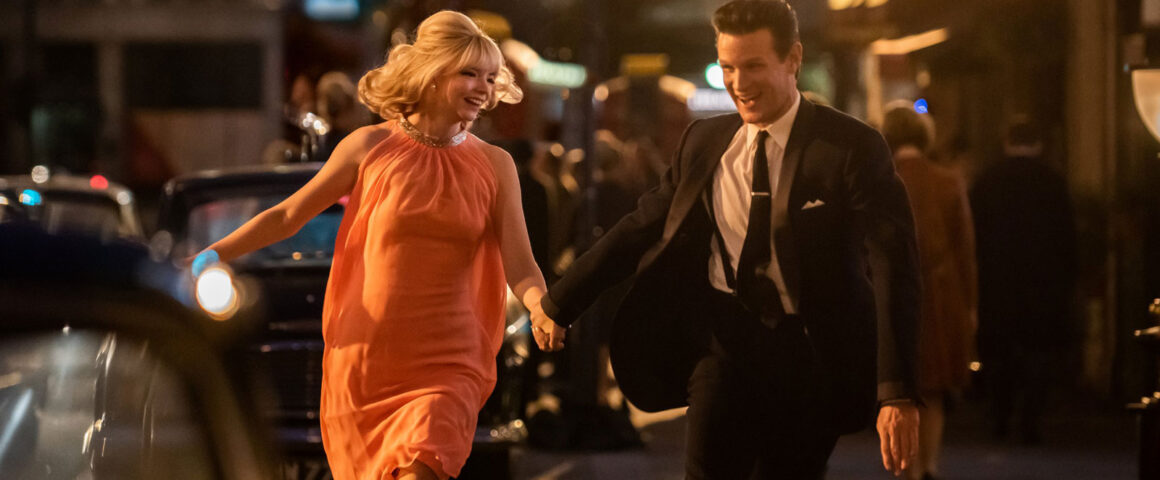London in the swinging 60s. A time of glamour. A place of dreams. An era of magic, cruelty and abuse. Wait, what? That’s right, Edgar Wright’s (the Cornetto Trilogy, “Baby Driver”) latest film, Last Night in Soho, largely eschews the lighthearted tone of his previous work, delivering a tale that is dark, gruesome and visceral, owing more to Italian giallo than English comedy.
Despite the grimmer tone, the visual stylistics are cranked up, Wright’s musical-esque flourishes combined with lurid color schemes that would make Dario Argento proud. Yet while “Suspiria,” “Inferno,” “Tenebrae” and their ilk have been described as stylistic experiments with loose plotting, Last Night in Soho offers a tightly focused narrative of trauma and grief. In typical Wright style, we are introduced to Eloise (Thomasin McKenzie, “The King”) in a dancelike sequence as she swings through her home in a self-designed and crafted dress, listening to the music of her grandmother Peggy (Rita Tushingham, “The Owners”). Eloise’s excitement is palpable as she receives acceptance to the London Fashion School, where she promptly moves from the sticks of Cornwall. The first act of the film follows Eloise settling into university life (which is somewhat Americanized): Cramped living conditions, awful new “friends,” one nice guy, waking up late and running to class, finding a new place to live, studying and creating new designs. Oh, and the small matter of experiencing the life of Sandy (Anya Taylor-Joy, “Glass”), a young woman in 60s London with dreams of her name in lights and a reality that is somewhat different.
The early scenes establish that Eloise sees more than others, such as the ghost of her mother (Aimee Cassettari) in mirrors. Thus, her haunting of and by Sandy are initially more exciting than unsettling. But are Eloise’s visions the products of a damaged mind or something more supernatural? The viewer is invited to be skeptical while also appreciating Eloise’s own conviction that her experiences are real. Nice guy John (Michael Ajao, “Attack the Block”) offers support and understanding, this tentative and timid relationship contrasted with the wild abandon of Sandy and cool but creepy Jack (Matt Smith, “Official Secrets”). But as the film progresses, Eloise becomes more like Sandy in terms of hairstyle, dress and even attitude, until she starts seeing Sandy and the horrors she encounters both in her dreams and while awake.
As a horror film of haunting, fractured perceptions and aggressive images, Last Night in Soho strikes the balance between being bonkers and disturbing. Wright along with editor Paul Machliss perfectly interweave the experiences of Eloise and Sandy, the film sometimes dancing as elegantly as the characters and also as furiously. Reflections are key as Eloise sees others than herself in mirrors and sometimes, they see her back. Director of photography, Chung-hoon Chung, brings the same kind of startling color and lighting that he does to the work of Park Chan-Wook like “The Handmaiden” and “Stoker,” neon signs that might seem garish instead looming off buildings like electrified gargoyles. Eloise is an engaging lead and Sandy perfectly embodies naivety and embitterment; her early performance of “Downtown” is spellbinding and makes her later arc all the more wounding, both for Eloise and the viewer. As Eloise digs deeper into Sandy’s story, the filmmaking becomes ever more intense, drawing the viewer along for the ride to the berserk finale.
The film also performs two fascinating sociological explorations. First, it highlights and condemns institutional misogyny. The 1960s that Wright presents is a world that uses and exploits women, because men have decided they can do what they like. Post #MeToo and the Weinstein scandal, the men of the film’s world are sadly recognizable, having instituted their exploitation of women into “the way things are done,” thus the women are expected, and indeed expect, to do what men tell them. Institutional misogyny is nothing new, both in terms of western culture generally and cinema in general, but Last Night in Soho does a fine job of highlighting the victim’s experience of earlier periods through contemporary eyes. Eloise’s trips back to the 60s include the sight of a “Thunderball” poster, a none-too-subtle indication that James Bond, especially of the Sean Connery era, is the epitome of patriarchal oppression.
By presenting its period setting in this negative light, Last Night in Soho performs critical nostalgia — looking back on something that is lost, with a sense of wistfulness because there is no denying the beauty and vivacity of the London Eloise visits, before demonstrating the dark and violent seediness of this lost time. Notably, at first Eloise wishes she lived in the 60s, but upon getting snatches of the experience realizes that savagery and abuse are inextricably linked with the glitz and glamor. Even in the first act the critique appears: A taxi driver objectifies Eloise in a way that is, frankly, revolting. As our protagonist learns and encounters more, we feel sicker and sicker. It is perhaps telling that the only decent male character in the whole film is a man of color, reminding viewers that white men, the figures of power and authority, are the ever-present and most severe danger.
This social critique, combined with Wright’s dazzling style and an intriguing script by Wright and Krysty Wilson-Cairns, make 97% of Last Night in Soho an exhilarating and horrifying dance macabre. During the final act, the film abandons a couple of its key conceits with an excess of revelatory twists, madness and music. This 3% is notably frustrating because the excessive aspect is quickly abandoned and we return to the more critical and engaging angle. It’s a shame that this brief sojourn is included at all because, aside from this, Last Night in Soho is a thoroughly entertaining watch that says some important things about how we view societal sacred cows. As Eloise says, for all the opportunities and fond memories, London is a bad place.



